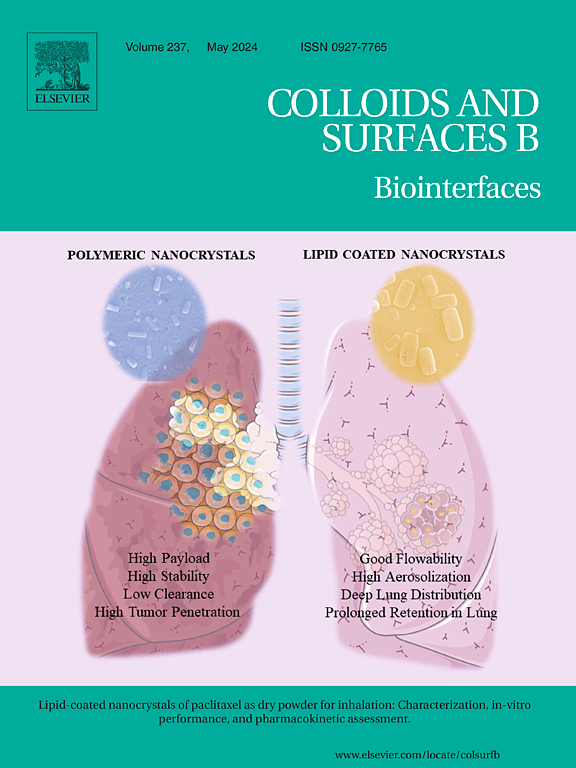用于功能性伤口敷料的 PVA-zein/α-tocopherol 非织造布垫的开发与表征。
IF 5.4
2区 医学
Q1 BIOPHYSICS
引用次数: 0
摘要
由于细菌感染、氧化应激等问题以及持续给药的需要,伤口愈合给临床带来了巨大挑战。本研究旨在开发和表征由聚(乙烯醇)(PVA)和玉米蛋白组成的、封装有α-生育酚的生物相容性非织造纤维垫,用于伤口敷料。采用抗溶剂共沉淀法将α-生育酚纳米封装在玉米蛋白中,然后将其分散在 PVA 溶液中。然后使用一种新颖、可扩展且成本低廉的溶液吹塑纺丝(SBS)工艺对所得到的成分进行加工,这种工艺能提供更高的产量来生成无纺布垫。经扫描电子显微镜确认,无纺布垫中的纤维直径从 350 纳米到 796 纳米不等,形态均匀。傅立叶变换红外光谱(FTIR)验证了α-生育酚的成功加入,而不会改变 PVA-zein基质的化学结构。流变学评估显示,随着生育酚含量的增加,α-生育酚具有牛顿特性,粘度降低,从而提高了毡垫的加工性能。机械测试表明,生育酚含量的增加提高了拉伸强度、伸长率和杨氏模量。这种垫子呈现出双相释放曲线,即初始爆发和 24 小时内持续释放 α-生育酚,符合 Korsmeyer-Peppas 模型,因此表明这是一种扩散控制机制。细胞毒性试验证实了其较高的细胞存活率(大于 90%)和较强的细胞铺展性,突出了其生物相容性。这些研究结果表明,PVA-zein/生育酚纤维毡具有持续的抗氧化活性和良好的伤口愈合环境,有望成为功能性伤口敷料的候选材料。今后的工作重点将是优化纤维成分以获得抗菌特性,并开展体内研究以验证其临床疗效。本文章由计算机程序翻译,如有差异,请以英文原文为准。
Development and characterization of PVA-zein/α-tocopherol nonwoven mats for functional wound dressing applications
Wound healing poses significant clinical challenges due to issues like bacterial infections, oxidative stress, and the need for sustained therapeutic delivery. This study aimed to develop and characterize biocompatible nonwoven fibrous mats composed of poly(vinyl alcohol) (PVA) and zein encapsulating α-tocopherol for wound dressing applications. α-Tocopherol was nano-encapsulated in zein proteins using an antisolvent co-precipitation method, followed by its dispersion in PVA solutions. The resulting composition was then processed using a novel, scalable, and inexpensive solution blow spinning (SBS) process that offers higher throughputs to generate non-woven mats. The resulting fibers in the non-woven mats, ranging in diameter from 350 nm to 796 nm, demonstrate uniform morphology, as confirmed by scanning electron microscopy. Fourier transform infrared (FTIR) spectroscopy validated the successful incorporation of α-tocopherol without altering the chemical structure of the PVA-zein matrix. Rheological assessments revealed Newtonian behavior and a decrease in viscosity with higher tocopherol content, enhancing the processability of the mats. Mechanical testing showed that increasing tocopherol content improved tensile strength, elongation, and Young's modulus. The mats exhibited a biphasic release profile with an initial burst and sustained α-tocopherol release over 24 h, fitting the Korsmeyer-Peppas model and hence indicating a diffusion-controlled mechanism. Cytotoxicity assays confirmed high cell viability (>90 %) and enhanced cell spreading, underscoring their biocompatibility. These findings suggest that PVA-zein/tocopherol fiber mats are promising candidates for functional wound dressing materials, offering sustained antioxidant activity and a favorable wound healing environment. Future work will focus on optimizing fiber composition for antimicrobial properties and conducting in vivo studies to validate their clinical efficacy.
求助全文
通过发布文献求助,成功后即可免费获取论文全文。
去求助
来源期刊

Colloids and Surfaces B: Biointerfaces
生物-材料科学:生物材料
CiteScore
11.10
自引率
3.40%
发文量
730
审稿时长
42 days
期刊介绍:
Colloids and Surfaces B: Biointerfaces is an international journal devoted to fundamental and applied research on colloid and interfacial phenomena in relation to systems of biological origin, having particular relevance to the medical, pharmaceutical, biotechnological, food and cosmetic fields.
Submissions that: (1) deal solely with biological phenomena and do not describe the physico-chemical or colloid-chemical background and/or mechanism of the phenomena, and (2) deal solely with colloid/interfacial phenomena and do not have appropriate biological content or relevance, are outside the scope of the journal and will not be considered for publication.
The journal publishes regular research papers, reviews, short communications and invited perspective articles, called BioInterface Perspectives. The BioInterface Perspective provide researchers the opportunity to review their own work, as well as provide insight into the work of others that inspired and influenced the author. Regular articles should have a maximum total length of 6,000 words. In addition, a (combined) maximum of 8 normal-sized figures and/or tables is allowed (so for instance 3 tables and 5 figures). For multiple-panel figures each set of two panels equates to one figure. Short communications should not exceed half of the above. It is required to give on the article cover page a short statistical summary of the article listing the total number of words and tables/figures.
 求助内容:
求助内容: 应助结果提醒方式:
应助结果提醒方式:


